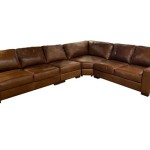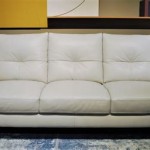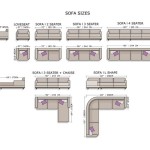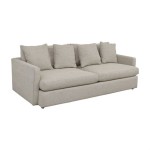Understanding the Standard Size of a One-Seater Sofa
The one-seater sofa, often referred to as an armchair or accent chair, plays a versatile role in interior design and functionality. Determining the standard size of a one-seater sofa is not always straightforward, as dimensions can vary based on design style, manufacturer, and intended use. However, understanding the general parameters allows for better space planning and informed purchasing decisions.
This article explores the typical dimensions of a one-seater sofa, examining the factors influencing size variations and offering insights into how these dimensions impact room layout and user comfort. It will also delve into the importance of considering more than just the overall size, touching upon seat depth, back height, and armrest dimensions.
Typical Dimensions of a One-Seater Sofa
While there isn't a universally fixed "standard" size, one-seater sofas generally fall within a certain range of dimensions. These dimensions include overall width, depth, and height. Understanding the typical ranges for each of these measurements provides a solid foundation for selecting the right piece of furniture.
Width: A standard one-seater sofa typically ranges from 30 to 45 inches (76 to 114 centimeters) in width. This measurement represents the overall width of the sofa, including the armrests. The specific width will depend on the design; for instance, a club chair with rolled arms will generally be wider than a mid-century modern armchair with slim, minimalist arms.
Depth: The depth of a one-seater sofa, measured from the front edge of the seat to the back, typically falls between 30 and 40 inches (76 to 102 centimeters). A deeper seat allows for more lounging space but might require more room in a smaller space. It's crucial to consider the depth in relation to the user's height to ensure comfortable seating posture. Shorter individuals might find a very deep seat less comfortable as it may not provide adequate back support.
Height: The overall height of a one-seater sofa usually ranges from 30 to 40 inches (76 to 102 centimeters). This measurement includes the legs, seat cushion, and backrest. The height of the backrest is important for providing adequate support. A higher backrest offers more support for the head and neck, while a lower backrest may be more aesthetically pleasing in certain settings. The seat height, which is the distance from the floor to the top of the seat cushion, is typically between 16 and 20 inches (41 to 51 centimeters). This dimension is crucial for ensuring comfortable ingress and egress from the chair.
Factors Influencing One-Seater Sofa Size
Several factors contribute to the variations observed in one-seater sofa sizes. These factors encompass design style, armrest type, leg style, and overall design aesthetic. Understanding these factors helps in discerning the right size and style to complement the existing decor and space.
Design Style: Different design styles inherently influence the dimensions of a one-seater sofa. For example, a traditional wingback chair, known for its tall back and enveloping wings, typically has a larger overall footprint than a sleek, contemporary armchair. Similarly, a Chesterfield chair, characterized by its rolled arms and deep button tufting, will generally be wider and deeper than a minimalist Scandinavian-inspired armchair.
Armrest Type: The design of the armrests significantly affects the overall width of the sofa. Rolled arms, commonly found in traditional designs, add considerable width compared to straight, minimalist arms. Armless chairs offer a more streamlined look and save space, making them suitable for smaller rooms. The height of the armrests also matters; lower armrests allow for greater freedom of movement, while higher armrests provide more support.
Leg Style: While legs don't drastically alter the width or depth, they influence the overall height and visual weight of the sofa. Tapered legs, common in mid-century modern designs, create a lighter, more airy feel. Block legs offer a more substantial and grounded appearance. Some sofas may have no visible legs, sitting directly on the floor, which reduces the overall height.
Padding and Upholstery: The amount of padding used in the seat, back, and arms can influence the overall dimensions. Overstuffed chairs will naturally be larger than those with minimal padding. The type of upholstery material also plays a role; thicker fabrics can add to the overall bulk of the sofa.
Intended Use: The intended use of the one-seater sofa should also be considered. If the sofa is intended for relaxing and lounging, a deeper and wider seat might be preferred. If it's intended for more formal seating or as an accent piece, a smaller, more upright design might be more suitable.
Impact on Room Layout and Comfort
The size of a one-seater sofa significantly impacts room layout and the overall comfort of a space. Careful consideration of the dimensions ensures a harmonious and functional arrangement.
Space Planning: Before purchasing a one-seater sofa, it's crucial to measure the available space. Consider the traffic flow around the sofa and ensure there is sufficient room to move comfortably. In small rooms, opting for a smaller armchair with slim arms can prevent the space from feeling cluttered. In larger rooms, a larger armchair can help fill the space and create a more inviting seating area. Also, consider the placement of other furniture items, such as coffee tables and side tables, in relation to the sofa.
Comfort and Ergonomics: The dimensions of the sofa directly impact comfort and ergonomics. Seat depth should be appropriate for the user's height to ensure proper back support. Seat height should allow for easy ingress and egress. The backrest should provide adequate support for the back and neck. Armrest height should allow for comfortable arm placement. Testing out the sofa before purchasing is highly recommended to ensure it meets individual comfort preferences.
Aesthetic Harmony: The size of the sofa should be proportional to the size of the room and the other furniture pieces. A small armchair might look out of place in a large room, while a large armchair might overwhelm a small room. Consider the overall style of the room and choose a sofa that complements the existing decor. The color and fabric of the sofa should also harmonize with the room's color scheme.
Accessibility: When selecting a one-seater sofa, consider accessibility needs. Individuals with mobility issues may require a higher seat height and sturdy armrests for support. Ensure that the sofa is easily accessible and does not obstruct pathways.
In conclusion, while a definitive "standard size" for a one-seater sofa remains elusive due to design variations and manufacturer specifications, understanding the typical range of dimensions—width, depth, and height—provides a valuable starting point. Carefully considering the influencing factors, such as design style, armrest type, and intended use, ensures that the chosen sofa complements the room’s layout, promotes comfort, and maintains aesthetic harmony within the space. Prioritizing these considerations leads to informed purchasing decisions and the selection of a one-seater sofa that perfectly balances functionality and style.

Pluto Single Seater Compact Office Sofa In Fabric Boss S Cabin

Buy Teak Wood One Seater Sofa Teaklab

Buy Godrej Interio Facet 1 Seater Sofa In Fabric Leaf Green Upto 65 Discount

Nill Astonic 1 Seater Fabric Sofa Beige Furniture

Single Seater Sofa

Buy Teak Wood One Seater Sofa Teaklab

Buy Teak Wood One Seater Sofa Teaklab

Verona Sofa Ash Grey Velvet Urban Ladder

Farina Sofa Ash Grey Velvet Urban Ladder

Buy Sky 1 Seater Sofa With Cushion In Ksa Homebox








